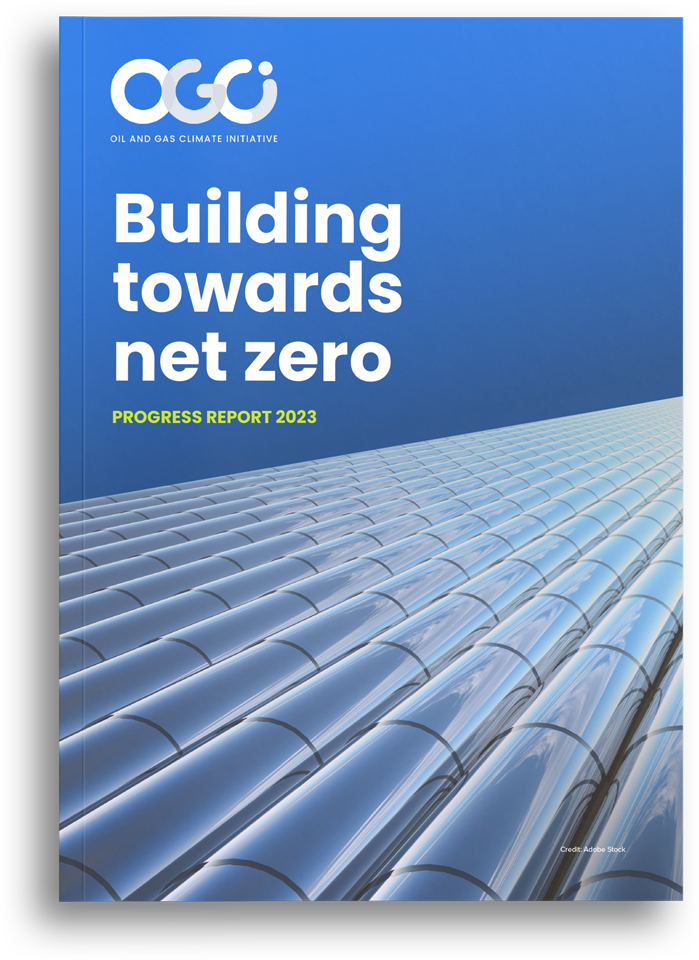Since its launch, OGCI has focused on building and strengthening the foundations to enable the deep decarbonization required to ensure a smooth energy transition that supports net zero.
This applies to our members’ operations and more broadly across the oil and gas industry as well as in other energy-intensive sectors.
Cutting emissions means transforming the way energy is produced and consumed and calls for many different solutions and low-carbon technologies. There is no single solution.
Alongside our work to reduce methane emissions and scale up CCUS, we have also worked on a range of solutions to decarbonize other sectors so we can achieve net zero. These include:
- Providing practical, actionable analysis that is underpinned by data to help decarbonize oil and gas operations, starting with our members but extending to our operating partners and the industry at large.
- Finding solutions to decarbonize transport, leveraging our members’ extensive expertise producing and supplying reliable transport fuels, and work on using mobile carbon capture for shipping.
- Finally, we have worked on the important role that natural climate solutions could play to complement decarbonization of the energy sector.
Decarbonizing oil and gas operations
Decarbonizing oil and gas operations will be critical to meeting the Paris Agreement goals. Scope 1 and 2 emissions from oil and gas operations were estimated to total just over 5 gigatonnes of CO2e in 2021.1
That is 15%1 of total energy-related emissions and 9%2 of global greenhouse gas emissions. The right regulatory and policy support and incentives would help efforts to reduce these emissions.
A recent study from OGCI’s Energy Efficiency workstream has shown that it is possible to decarbonize the majority of Scope 1 and 2 emissions in refineries by using electricity generated from low-carbon sources to power some equipment instead of fossil fuels.
The study, conducted by global consultancy and engineering company Wood Plc., found that using electric boilers and electric drives for condensing turbines should be prioritized as they are proven technologies and have marginal abatement costs under $150 per tonne of CO2.
The primary roadmap which reduces over 65% of a refinery’s CO2 could be achieved by 2040 if there is sufficient availability of low-carbon power, the study found.
“Decarbonizing the refining sector, which emits around 1 gigatonne of CO2e a year, will play an important role in achieving a net zero emissions future and our latest study on the refinery sector sets out pathways to support that goal.”
Justine Roure,
OGCI Deputy Vice President Strategy & Policy

Decarbonizing transport
Decarbonizing transport is critical to all pathways to get to net zero.
The transport sector emits almost a quarter of total energy-related carbon dioxide emissions.
While the passenger vehicle sector is already transitioning toward electric power, electrification is not so straightforward for heavy duty long-haul trucking, deep-sea marine vessels and long-distance aviation.
A key inhibitor to electrifying these sectors is the size and weight of the batteries required to store the electric energy required.
OGCI has focused decarbonization efforts on areas where our members already have extensive expertise – producing and supplying reliable lower carbon liquid and gaseous fuels for transport and developing mobile applications of carbon capture and storage for shipping.
To build a foundation, we have worked on a ground-up examination of the opportunities and challenges of scaling up key low-carbon liquid fuels that can be used in existing engines, such as biofuels, methanol and ammonia, and synthetic fuels, either on their own or blended.
We have also studied the use of hydrogen for transport.
These studies have worked to understand the fuels, the potential market size, sustainability, safety measures and infrastructure that would be required.
Low-carbon fuels and hydrogen

Biofuels
Can be used in any vehicle

Can be used in light- and heavy-duty vehicles and airplanes

Ammonia and methanol
Can be used in shipping

E-fuels (synthetic fuels)
Can be used in any vehicle
Progress in 2023
In 2023, we began to investigate practical steps on how the industry can meet future demand for these fuels.
On the supply side, we are working on a plan to create a set of standards for potential refinery feedstocks – known as renewable crudes – that will be used to make some of the low-carbon fuels.
This will enable refiners to understand the feedstock they receive, allowing them to appropriately manage the refining process at their facilities.
This work would eventually help facilitate discussions with standard setting organizations, such as the International Standards Organization or ASTM, to help drive the development and scale up of a renewable crude market.
Currently, there is a lot of variability around renewable crudes and that complicates processing and refining, potentially curbing a faster scale up of the market.
On the demand side, we are evaluating what the transport sector fuels market will look like in 2050 in specific regions under current policies for a net zero scenario.
The forecasts we are developing will aid the industry’s understanding of what and where the opportunities will be for low-carbon fuels.
Early results from a forthcoming study of the EU market show that under current policy and carbon price expectations, demand for low-carbon fuels and hydrogen is expected to be significant in 2050. We have now extended this analysis to transport markets in the US, China and Brazil.
What are renewable crudes?
- Renewable crudes are made from a variety of feedstocks and processes
- Examples include biofuel feedstocks upgraded by pyrolysis or hydrothermal liquefaction and e-crudes (synthetic fuels)
- Renewable crudes can be considered as analogues to fossil crudes allowing some of them to use the same infrastructure
- They can be used to help decarbonize the transport sector
Decarbonizing shipping
Decarbonizing shipping fits in with our strategy to use our expertise and technology to help other sectors and industries decarbonize.
Like many other sectors and industries, decarbonization here will require a range of solutions.
In this area, our work has focused on where we can add value by leveraging our members’ extensive expertise producing and supplying reliable transport fuels. So we have been supporting the development of low-carbon fuels, such as biofuels, ammonia and methanol for shipping.
We have begun work on a study of the percentage of specific low-carbon fuels that could be blended into the heavy fuels used in the marine market to reduce carbon intensity in existing vessels.
Initial investigations look positive but further laboratory investigation would be required to validate findings.
Until greater supplies of low carbon fuels are available, parts of the transportation network would need other options to decarbonize. We also studied the feasibility of using carbon capture technologies on board a vessel.
Carbon capture and storage has long been a priority for OGCI and our member companies have significant experience applying this technology.
In 2019, we partnered with tanker shipping company Stena Bulk to launch a feasibility study with The Netherlands Organization for Applied Scientific Research. Other consortium members, including the Global Centre for Maritime Decarbonisation, heavy industry supplier Alfa Laval and others, joined our efforts in 2021 to explore the installation of a carbon capture system on board a medium range tanker.
Helping to reduce the carbon intensity from the use of oil and chemical tankers to distribute products around the world is a way to help some of our members reduce a portion of their Scope 1 and 2 emissions from shipping.
Natural climate solutions
Value of natural climate solutions
- UN IPCC net zero scenarios that include NCS show the transition for society could be quicker and cost less4
- NCS include the conservation, restoration and sustainable use of forests, grasslands, coastal vegetation, agricultural soils, wetlands, and other ecosystems in ways that mitigate climate change and enhance climate resilience5
- NCS has many potential benefits, including helping to protect communities’ resilience to climate impacts, economic growth and diversification, improvement of human health and livelihood and protection of biodiversity and water resources

OGCI's NCS initiatives include:
- Working with Ipieca to update guidelines and best practice for the oil and gas industry to help
companies preserve and restore natural carbon sinks as a result of operations and development. - Supporting the NCS Alliance’s work to develop a procurement guide for buyers.
- Early-stage work to identify and scale up potential technologies to monitor, report and verify emissions reductions from NCS to ensure transparency.
- As per International Energy Agency and European Commission EDGAR (Emissions Database for Global Atmospheric Research).
- IPCC Sixth Assessment Report.
- OGCI position paper on natural climate solutions.
- Source: Intergovernmental Panel on Climate Change, Global Warming of 1.5 °C, 2018.
- Natural Climate Solutions: high carbon stock ecosystems management guidance










